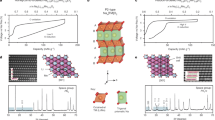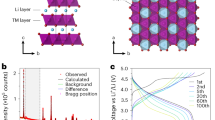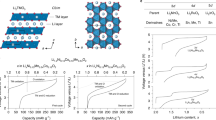Abstract
Oxide ions in transition metal oxide cathodes can store charge at high voltage offering a route towards higher energy density batteries. However, upon charging these cathodes, the oxidized oxide ions condense to form molecular O2 trapped in the material. Consequently, the discharge voltage is much lower than charge, leading to undesirable voltage hysteresis. Here we capture the nature of the electron holes on O2− before O2 formation by exploiting the suppressed transition metal rearrangement in ribbon-ordered Na0.6[Li0.2Mn0.8]O2. We show that the electron holes formed are delocalized across the oxide ions coordinated to two Mn (O–Mn2) arranged in ribbons in the transition metal layers. Furthermore, we track these delocalized hole states as they gradually localize in the structure in the form of trapped molecular O2 over a period of days. Establishing the nature of hole states on oxide ions is important if truly reversible high-voltage O-redox cathodes are to be realized.
This is a preview of subscription content, access via your institution
Access options
Access Nature and 54 other Nature Portfolio journals
Get Nature+, our best-value online-access subscription
$29.99 / 30 days
cancel any time
Subscribe to this journal
Receive 12 digital issues and online access to articles
$119.00 per year
only $9.92 per issue
Buy this article
- Purchase on Springer Link
- Instant access to full article PDF
Prices may be subject to local taxes which are calculated during checkout






Similar content being viewed by others
Data availability
All the data generated or analysed during this study are included in the published article and its Supplementary Information. Source data are provided with this paper.
References
Lu, Z. & Dahn, J. R. Understanding the anomalous capacity of Li/Li[NixLi(1/3−2x/3)Mn(2/3−x/3)]O2 cells using in situ X-ray diffraction and electrochemical Studies. J. Electrochem. Soc. 149, A815 (2002).
Lu, Z., Beaulieu, L. Y., Donaberger, R. A., Thomas, C. L. & Dahn, J. R. Synthesis, structure, and electrochemical behavior of Li[NixLi1/3−2x/3Mn2/3−x/3]O2. J. Electrochem. Soc. 149, A778 (2002).
Koga, H. et al. Reversible oxygen participation to the redox processes revealed for Li1.20Mn0.54Co0.13Ni0.13O2. J. Electrochem. Soc. 160, A786–A792 (2013).
Luo, K. et al. Charge-compensation in 3d-transition-metal-oxide intercalation cathodes through the generation of localized electron holes on oxygen. Nat. Chem. 8, 684–691 (2016).
Johnson, C. S. et al. The significance of the Li2MnO3 component in ‘composite’ xLi2MnO3 · (1 − x)LiMn0.5Ni0.5O2 electrodes. Electrochem. Commun. 6, 1085–1091 (2004).
Saubanère, M., McCalla, E., Tarascon, J.-M. & Doublet, M.-L. The intriguing question of anionic redox in high-energy density cathodes for Li-ion batteries. Energy Environ. Sci. 9, 984–991 (2016).
Seo, D.-H. et al. The structural and chemical origin of the oxygen redox activity in layered and cation-disordered Li-excess cathode materials. Nat. Chem. 8, 692–697 (2016).
Gent, W. E. et al. Coupling between oxygen redox and cation migration explains unusual electrochemistry in lithium-rich layered oxides. Nat. Commun. 8, 2091 (2017).
Tran, N. et al. Mechanisms associated with the “plateau” observed at high voltage for the overlithiated Li1.12(Ni0.425Mn0.425Co0.15)0.88O2 system. Chem. Mater. 20, 4815–4825 (2008).
Assat, G. et al. Fundamental interplay between anionic/cationic redox governing the kinetics and thermodynamics of lithium-rich cathodes. Nat. Commun. 8, 2219 (2017).
Yabuuchi, N. et al. Origin of stabilization and destabilization in solid-state redox reaction of oxide ions for lithium-ion batteries. Nat. Commun. 7, 13814 (2016).
Zhao, E. et al. Local structure adaptability through multi cations for oxygen redox accommodation in Li-rich layered oxides. Energy Storage Mater. 24, 384–393 (2020).
Zhang, M. et al. Pushing the limit of 3d transition metal-based layered oxides that use both cation and anion redox for energy storage. Nat. Rev. Mater. 7, 522–540 (2022).
Li, M. et al. Cationic and anionic redox in lithium-ion based batteries. Chem. Soc. Rev. 49, 1688–1705 (2020).
Yu, Y. et al. Towards controlling the reversibility of anionic redox in transition metal oxides for high-energy Li-ion positive electrodes. Energy Environ. Sci. 14, 2322–2334 (2021).
Gent, W. E., Abate, I. I., Yang, W., Nazar, L. F. & Chueh, W. C. Design rules for high-valent redox in intercalation electrodes. Joule 4, 1369–1397 (2020).
Assat, G. & Tarascon, J. M. Fundamental understanding and practical challenges of anionic redox activity in Li-ion batteries. Nat. Energy 3, 373–386 (2018).
House, R. A. et al. First-cycle voltage hysteresis in Li-rich 3d cathodes associated with molecular O2 trapped in the bulk. Nat. Energy 5, 777–785 (2020).
House, R. A. et al. The role of O2 in O-redox cathodes for Li-ion batteries. Nat. Energy 6, 781–789 (2021).
House, R. A. et al. Detection of trapped molecular O2 in a charged Li-rich cathode by neutron PDF. Energy Environ. Sci. 15, 376–383 (2022).
House, R. A. et al. Superstructure control of first-cycle voltage hysteresis in oxygen-redox cathodes. Nature 577, 502–508 (2020).
Du, K. et al. Exploring reversible oxidation of oxygen in a manganese oxide. Energy Environ. Sci. 9, 2575–2577 (2016).
Gao, A. et al. Topologically protected oxygen redox in a layered manganese oxide cathode for sustainable batteries. Nat. Sustain. 5, 214–224 (2022).
Rong, X. et al. Structure-induced reversible anionic redox activity in Na layered oxide cathode. Joule 2, 125–140 (2018).
Eum, D. et al. Coupling structural evolution and oxygen-redox electrochemistry in layered transition metal oxides. Nat. Mater. 21, 664–672 (2022).
Kim, E. J. et al. Importance of superstructure in stabilizing oxygen redox in P3-Na0.67Li0.2Mn0.8O2. Adv. Energy Mater. 12, 2102325 (2022).
Abate, I. I. et al. Coulombically-stabilized oxygen hole polarons enable fully reversible oxygen redox. Energy Environ. Sci. 14, 4858–4867 (2021).
Kitchaev, D. A., Vinckeviciute, J. & van der Ven, A. Delocalized metal-oxygen π-redox Is the origin of anomalous nonhysteretic capacity in Li-ion and Na-ion cathode materials. J. Am. Chem. Soc. 143, 1908–1916 (2021).
Tsuchimoto, A. et al. Nonpolarizing oxygen-redox capacity without O–O dimerization in Na2Mn3O7. Nat. Commun. 12, 631 (2021).
Sudayama, T. et al. Multiorbital bond formation for stable oxygen-redox reaction in battery electrodes. Energy Environ. Sci. 13, 1492–1500 (2020).
Zhao, C., Liu, H., Geng, F., Hu, B. & Li, C. Stable electronic structure related with Mn4+O−• coupling determines the anomalous nonhysteretic behavior in Na2Mn3O7. Energy Storage Mater. 48, 290–296 (2022).
Sathiya, M. et al. Reversible anionic redox chemistry in high-capacity layered-oxide electrodes. Nat. Mater. 12, 827–835 (2013).
McCalla, E. et al. Visualization of O–O peroxo-like dimers in high-capacity layered oxides for Li-ion batteries. Science 350, 1516–1521 (2015).
Hong, J. et al. Metal-oxygen decoordination stabilizes anion redox in Li-rich oxides. Nat. Mater. 18, 256–265 (2019).
Yabuuchi, N. et al. A new electrode material for rechargeable sodium batteries: P2-type Na2/3[Mg0.28Mn0.72]O2 with anomalously high reversible capacity. J. Mater. Chem. A 2, 16851–16855 (2014).
House, R. A. et al. Covalency does not suppress O2 formation in 4d and 5d Li-rich O-redox cathodes. Nat. Commun. 12, 2975 (2021).
Clément, R. J. et al. Spin-transfer pathways in paramagnetic lithium transition-metal phosphates from combined broadband isotropic solid-state MAS NMR spectroscopy and DFT calculations. J. Am. Chem. Soc. 134, 17178–17185 (2012).
Dundon, J. M. 17O NMR in liquid O2. J. Chem. Phys. 76, 2171–2173 (1982).
Arhammar, C. et al. Unveiling the complex electronic structure of amorphous metal oxides. Proc. Natl Acad. Sci. USA 108, 6355–6360 (2011).
Boivin, E. et al. Bulk O2 formation and Mg displacement explain O-redox in Na0.67Mn0.72Mg0.28O2. Joule 5, 1267–1280 (2021).
ben Yahia, M., Vergnet, J., Saubanère, M. & Doublet, M.-L. Unified picture of anionic redox in Li/Na-ion batteries. Nat. Mater. 18, 496–502 (2019).
Zhou, K. J. et al. I21: an advanced high-resolution resonant inelastic X-ray scattering beamline at Diamond Light Source. J. Synchrotron Radiat. 29, 563–580 (2022).
Dovesi, R. et al. Quantum-mechanical condensed matter simulations with CRYSTAL. Wiley Interdiscip. Rev. Comput Mol. Sci. 8, e1360 (2018).
Seymour, I. D. et al. Characterizing oxygen local environments in paramagnetic battery materials via 17O NMR and DFT calculations. J. Am. Chem. Soc. 138, 9405–9408 (2016).
Kim, J. et al. Linking local environments and hyperfine shifts: a combined experimental and theoretical 31P and 7Li solid-state NMR study of paramagnetic Fe(III) phosphates. J. Am. Chem. Soc. 132, 16825–16840 (2010).
Middlemiss, D. S., Ilott, A. J., Clément, R. J., Strobridge, F. C. & Grey, C. P. Density functional theory-based bond pathway decompositions of hyperfine shifts: equipping solid-state NMR to characterize atomic environments in paramagnetic materials. Chem. Mater. 25, 1723–1734 (2013).
Monkhorst, H. J. & Pack, J. D. Special points for Brillouin-zone integrations. Phys. Rev. B 13, 5188 (1976).
Acknowledgements
We are indebted to the Engineering and Physical Sciences Research Council (EPSRC), the Henry Royce Institute for Advanced Materials (EP/R00661X/1, EP/S019367/1, EP/R010145/1, EP/L019469/1) and the Faraday Institution (FIRG007, FIRG008, FIRG016) for financial support. We thank the HEC Materials Chemistry Consortium (EP/R029431/1) for supercomputer facilities. We acknowledge Diamond Light Source for time on I21 under proposal MM25589-1. This project was supported by the Royal Academy of Engineering under the Research Fellowship scheme. B.J.M. acknowledges support from the Royal Society (UF130329 and URF\R\191006). For the purpose of open access, the author has applied a CC BY public copyright licence to any author accepted manuscript (AAM) version arising from this submission.
Author information
Authors and Affiliations
Contributions
R.A.H. planned and conducted the synthesis and characterization work. R.A.H. and S.C. planned and conducted the SQUID measurements. R.A.H. prepared the 17O-labelled samples and G.J.R. performed and fitted the 17O MAS NMR. R.A.H. and J.-J.M. in close collaboration with M.G-F., A.N. and K.-J.Z. conducted the RIXS and XAS measurements. K.M. conducted the DFT computation and NMR shift modelling with the support of B.J.M. and M.S.I. R.A.H. and P.G.B. wrote the manuscript with contributions from all authors.
Corresponding authors
Ethics declarations
Competing interests
The authors declare no competing interests.
Peer review
Peer review information
Nature Energy thanks Wei Kong Pang, Dong-Hwa Seo and Stefan Topolovec for their contribution to the peer review of this work.
Additional information
Publisher’s note Springer Nature remains neutral with regard to jurisdictional claims in published maps and institutional affiliations.
Supplementary information
Supplementary Information
Supplementary Note, Tables 1 and 2 and Figs. 1–11.
Source data
Source Data Fig. 2
SQUID source data.
Rights and permissions
Springer Nature or its licensor (e.g. a society or other partner) holds exclusive rights to this article under a publishing agreement with the author(s) or other rightsholder(s); author self-archiving of the accepted manuscript version of this article is solely governed by the terms of such publishing agreement and applicable law.
About this article
Cite this article
House, R.A., Rees, G.J., McColl, K. et al. Delocalized electron holes on oxygen in a battery cathode. Nat Energy 8, 351–360 (2023). https://doi.org/10.1038/s41560-023-01211-0
Received:
Accepted:
Published:
Issue Date:
DOI: https://doi.org/10.1038/s41560-023-01211-0
This article is cited by
-
Phase segregation and nanoconfined fluid O2 in a lithium-rich oxide cathode
Nature Materials (2024)
-
Mn-based cathode materials for rechargeable batteries
Science China Chemistry (2024)
-
Capturing the hole states of oxygen
Nature Energy (2023)



